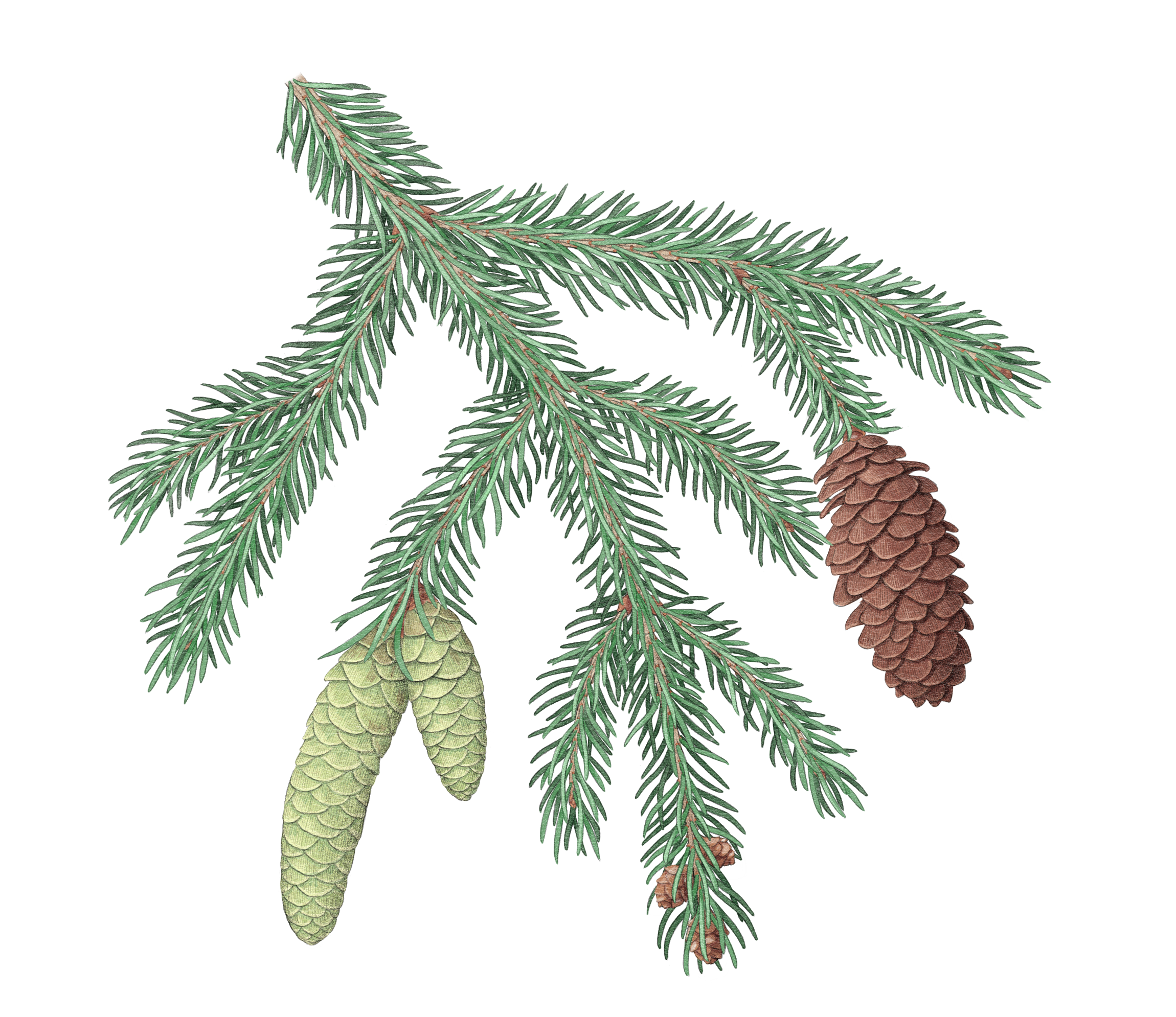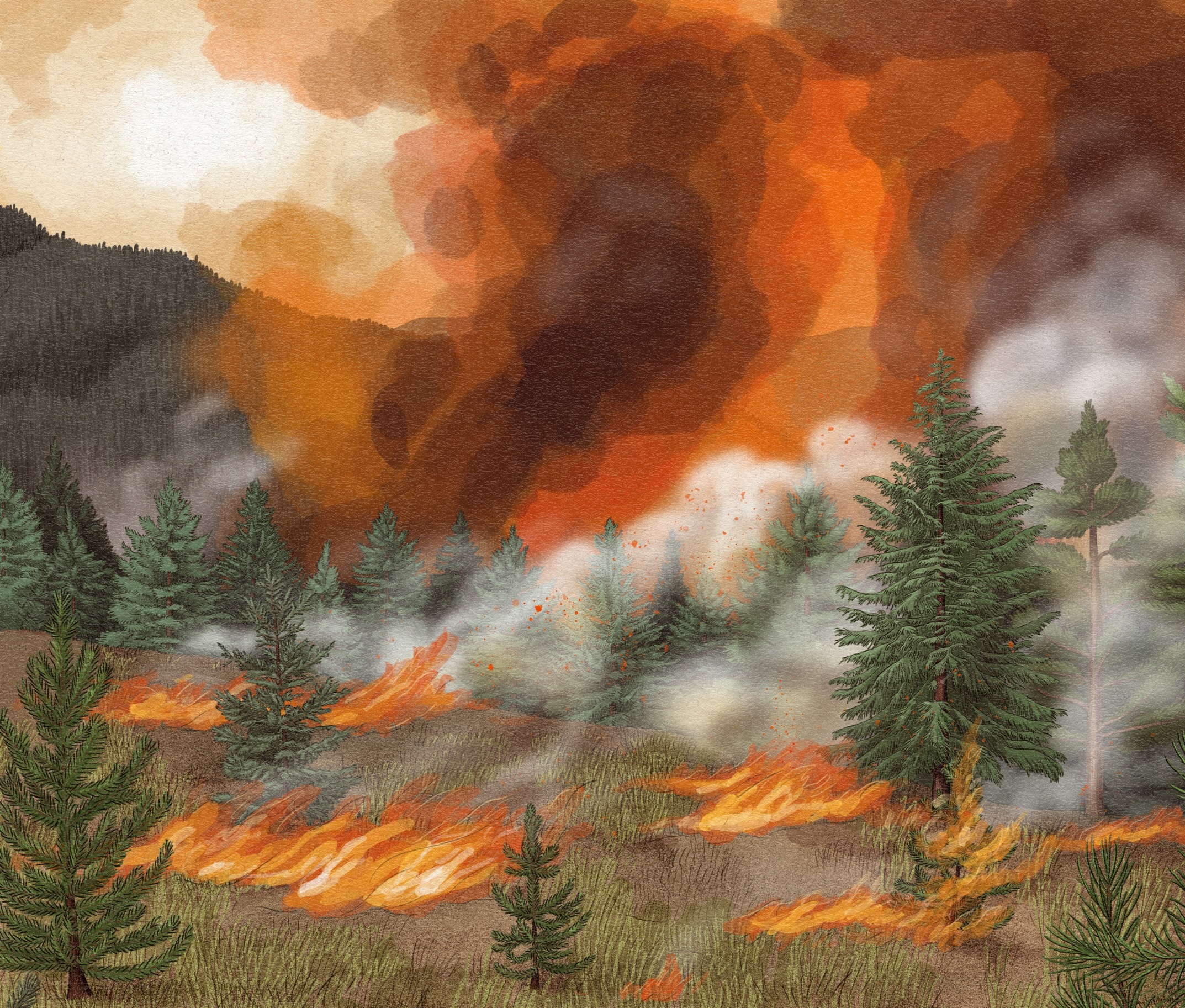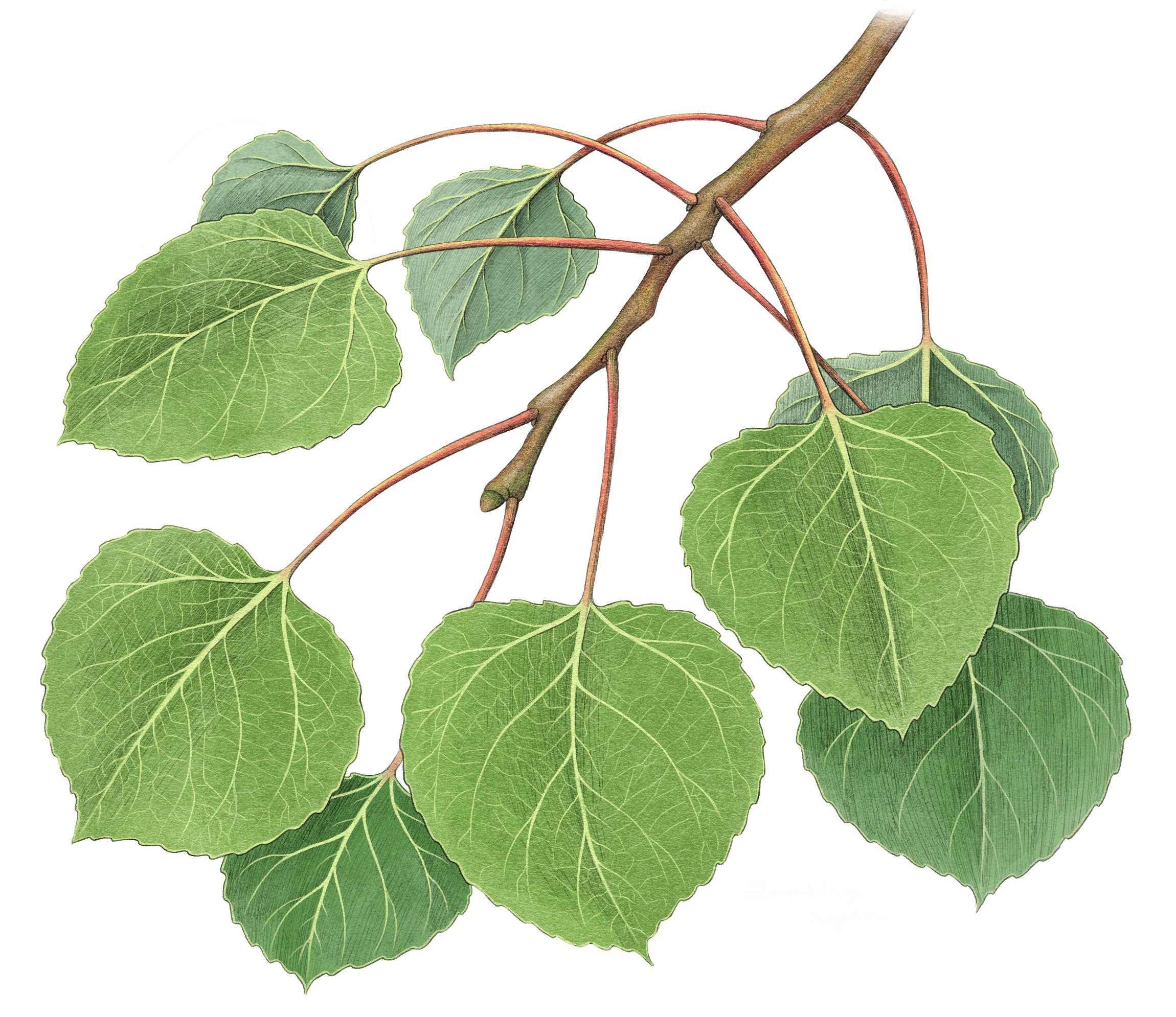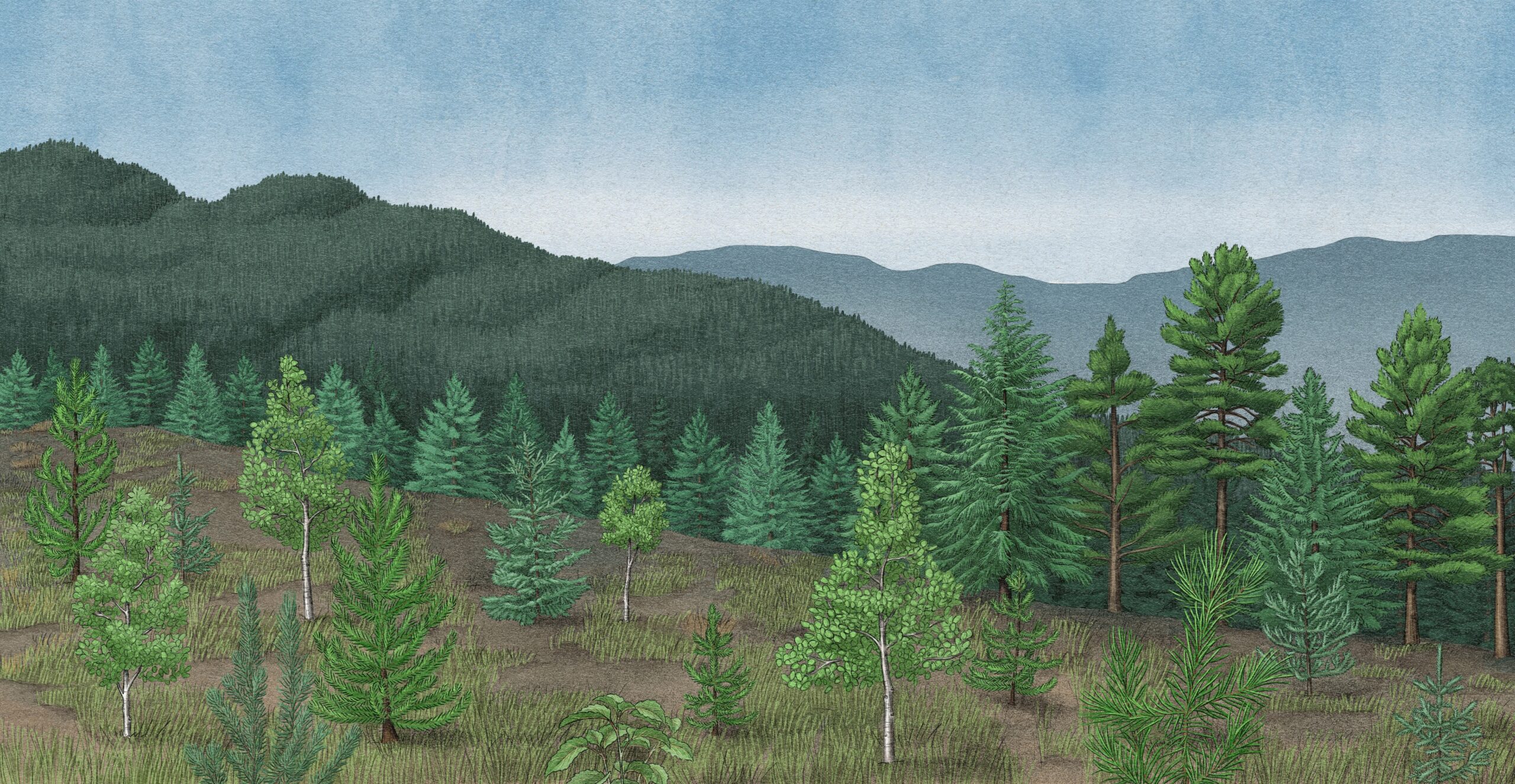
‘Afraid of the water’? Life in a city that dumps billions of litres of raw sewage into lakes and rivers
10 billion litres of sewage are dumped into Winnipeg’s lakes and rivers each year. Some...
Get the inside scoop on The Narwhal’s environment and climate reporting by signing up for our free newsletter.
For decades, forestry companies in B.C. have used chemical herbicides like glyphosate to kill off plants that might compete with trees destined for timber. Trembling aspen, named for its almost heart-shaped leaves that seem to quiver in the wind, is often on the hit list.
But after years of destructive wildfires that have wiped out whole neighbourhoods and sometimes whole towns, more and more people are questioning the wisdom of killing off this tree. Because when wildfires sweep across the landscape, aspen can help calm the flames.
Aspen is found across North America, dotted along riverbanks or in stands the size of a dozen or more football fields all stitched together. It’s the most common of the continent’s deciduous trees, which lose their leaves each fall and sprout new ones each spring. Aspen can grow from seed planted by hand or carried on the wind to fertile ground. But the tree often spreads by clone, through vast root networks that can sprout thousands of genetic replicas — each one the branch of a single, sometimes ancient organism.
In B.C. aspen is found sprinkled along the mighty rivers that wind through the southwest, in patches across the southern Interior and in groves that mark the transition from prairie to boreal forest. Wherever the trees grow, they’re important. Beavers prefer aspen trunks and twigs to build their dams. Birds nest in their cavities. Moose, deer and black bears eat their leaves.
And in the summer, when aspens are lush and green, they act like a sponge, holding moisture from the forest floor in their bark and leaves. Conifers, by contrast, are drier, and their needles are packed full of flammable resin. Where conifers spur on fire, aspens can slow it down.
But for industry, the money is in conifers.

B.C. has been farming conifers for decades. Telephone poles and packing crates, kitchen cabinets, furniture and even whole houses are made from these evergreen trees.
About 50 species of tree occur in B.C. But after companies clear cut stretches of forest, they mostly plant conifers — pine, spruce and fir.
Companies are responsible for the conifer crops until the trees are considered “free growing” — meaning their growth isn’t impeded by other vegetation that might compete for water, nutrients and sunlight.
To make sure they hit those targets, and to avoid potential fines from the B.C. government for missing that milestone, companies use chemical herbicides like glyphosate to kill off aspen, huckleberries, wild rose and a host of other plants they see as potential competitors for conifers. They use backpack tanks to target species from the ground and helicopters to douse large areas from the air.
Glyphosate, which the World Health Organization says is probably carcinogenic to people, is the main component in the common herbicide Roundup. Plants absorb the chemical — which blocks them from taking in nutrients from the soil — through their leaves. As the plant starves, its colour fades, its leaves shrivel and then it dies.
“They’re doing this because they think they can make more money from growing conifers on short rotations,” forest ecologist Suzanne Simard says. But “the costs to the ecosystems are huge,” she tells The Narwhal. “It’s devastating.”
James Steidle, founder of Stop the Spray B.C., a group advocating for an end to glyphosate spraying, describes the changes to the landscape wrought by modern forest practices as “incredibly dramatic.”
Fly over a forested area and you’ll see a “monotone, olive green patch of pine trees,” he says. “You can see it from space … you can see it driving down the road.”
FP Innovations, a non-profit focused on research and development in the forestry sector, was commissioned by the B.C. government to review glyphosate use in the industry. The group’s 2019 report said controlling “highly aggressive” competitors like fireweed and trembling aspen is sometimes necessary to establish conifer plantations.
“The unimpeded growth of conifers maximizes timber supply in the long term and the economic benefit derived from forests,” the review says.
In many parts of B.C. — and in Quebec, where glyphosate has been banned for more than 20 years — companies cut back competing vegetation with brush saws and plant taller seedlings to give their conifer crops an edge. But glyphosate is a less expensive option, according to the FP Innovations report.
Forestry companies ramped up herbicide spraying in the 1980s, but government data analyzed for The Narwhal by Nikita Wallia, a spatial analyst and cartography specialist, shows some of the earliest reports of herbicide spraying date back to the 1970s. Since then, more than one million hectares of forest in B.C. have been sprayed with herbicides, while plants that might compete with conifers have been manually cut back from an additional 1.5 million hectares, according to the data.
The area forestry companies spray with herbicides each year in B.C. has declined since 1989, when it peaked at 40,000 hectares, according to the FP Innovations report. But large stretches of forest are still sprayed with glyphosate and other herbicides annually. Between 2018 and 2023, forestry companies sprayed 52,614 hectares of forest — an area almost five times the size of Vancouver — to kill off aspen and other plants, according to Wallia’s analysis. Another 183,380 hectares were manually cut back over the same period.
In an emailed statement in response to questions, a spokesperson for B.C.’s Ministry of Forests said the use of herbicides in forestry has declined by 88 per cent since 2018, adding, “the province works with foresters to grow trees without glyphosate.”
But even as the practice becomes less common, the consequences of decades of glyphosate spraying are still visible in forests today. And while Steidle says manually cutting back deciduous trees is better than spraying herbicides, he warns it can still have “huge impacts” on aspen communities and on forest biodiversity.
Many plants the forest industry targets as competitors to conifers provide food not just for deer, moose, bears and birds but also for people, who harvest berries and medicinal plants from the land. Mixed forests, made up of diverse species, have been found to be more resistant to pests and disease. Aspen, maples, poplars and other deciduous trees return nutrients to the soil when their leaves fall each autumn.
And each summer, when wildfires spread across the landscape, moist groves of aspen can help temper the flames. But those benefits are eroded or lost as deciduous trees and other plants are weeded out.
“Anytime we apply herbicides, we are changing potential fire behaviour,” wildland fire ecologist Robert Gray explains. In past decades, herbicides were used to prepare for prescribed burns, especially in wetter ecosystems, he points out. “Today we’re just trying to kill vegetation that’s competing with planted conifers — the unfortunate side effect is that we create a hazardous fire condition.”
If it doesn’t burn, dead, dried-out brush killed off by herbicides will eventually decompose, lessening the immediate fire risk. But in areas where aspen and other deciduous trees are killed, a natural fire break is lost too.

“We talk about mature aspen as wet blankets or speed bumps on the landscape,” Gray, a private consultant, says. “So, if we kill regenerating aspen, we’re changing the trajectory for a landscape’s potential fire behaviour.”
Jen Baron, a fire ecologist and post-doctoral researcher at the University of British Columbia Okanagan, points to B.C.’s northern boreal and sub-boreal forests as an example. In the past, those areas would have been home to conifer forests, mixed conifer and deciduous forests and patches of pure aspen or other deciduous hardwood trees, often in wetter areas.
“We’ve effectively excluded a lot of those wetter forests over longer periods of time and simultaneously dried out the landscape,” she says.
Even if an aspen clone survives a dose of chemical herbicide, by the time new sprouts emerge their chances of survival may be limited. As conifers shoot upwards, past their free-growing milestone, the canopy closes, casting shadows across the plants below. But growing aspen can’t handle the shade.
Historically, fire would sweep through every so often, thinning the trees and letting the light back in, allowing aspen stands to regenerate. But for decades B.C. has suppressed fire on the landscape to protect its standing timber — simultaneously extinguishing the chances for aspen renewal after herbicides are applied.
The consequences can be far reaching. While dense conifer forests offer little to nourish wildlife and people, deciduous forests are lush with food. “Beneath the hardwood canopy, you still have berries and rootstock, all kinds of other plant species, but you don’t have that in conifer forests,” Gray says.
While conifer growth is the priority of the B.C. government and forest industry, the goal isn’t to completely eliminate other vegetation, according to the FP Innovations report. It points to research that found deciduous plants accounted for 15 to 21 per cent of forest density years after herbicide treatment in the Omineca region, which surrounds Prince George, B.C.
But Steidle warns glyphosate can affect the long-term health of aspen, even when it doesn’t kill the tree. And small patches of aspen the helicopter sprayers miss may succumb to frequent gnawing from rabbits, moose or beavers. “A lot of things will eat aspen trees other than brush saws and herbicide helicopters,” Steidle points out.
B.C.’s regulations allow for a fair bit of aspen mixed in among conifers in forests managed for timber, Steidle notes. But simply having aspen in the mix of a conifer-dominant forest won’t do much in the face of a wildfire.
Aspens aren’t a foolproof fire guard. They dry out in the winter, and only when their leaves unfold from their buds each spring do they start to hold in moisture. Even then, Gray says, groves of almost entirely deciduous trees — such as aspen, alder or birch — are needed to reap those fuel break benefits. The trees must be tall enough and dense enough that their leafy canopies close, shading the forest floor and trapping moisture in the soils and foliage below.
“We need more aspen trees, we need more of those species that can reduce wildfire,” Steidle says.
B.C.’s regulations require companies to prioritize conifers across 95 per cent of each cutblock they replant in the central Interior, Steidle says. In practice, it means companies are obliged to kill off pure aspen and birch stands across most of their plantations in the region, he says. And even in the remaining five per cent, he says aspen stands can’t be larger than two hectares.
“Their war on aspen, the war on deciduous trees, is directly linked to the greed of corporations and the government today.”
In a statement, a spokesperson for the Forests Ministry said climate change and aspen leafminers, tiny moths that eat tree leaves, are the most significant cause of aspen declines. While Steidle agrees the pests are a concern, he says policies that restrict aspen in conifer plantations only compound existing pressures on these deciduous trees. “We’ve got to stop cutting down aspen, we’ve got to stop spraying aspen,” he says. “Nature can heal itself but we’ve got to get out of the way.”
Forest ecologist Simard has long questioned B.C.’s free-to-grow policy. Even as a young graduate student, she recognized the interconnected nature of forest ecosystems and questioned the wisdom of killing off neighbouring plants to hasten conifer growth. With some of her earliest research, in the 1980s and 1990s, Simard set out to test whether the free-to-grow policy would accomplish that goal.
In a series of experiments in different forest types, she and other researchers tested whether removing deciduous trees, shrubs, grasses and wildflowers — by cutting them back or dousing them with chemical herbicides — led to faster-growing conifers. The results varied depending on the plant communities, Simard explains. In some cases, particularly in wetter ecosystems where brush grows fast and dense, conifer seedlings did fare better when neighbouring plants were knocked back. But in other places, there was little to no benefit for conifers, Simard says, and it may have even caused them harm.
Over the years, Simard kept an eye on an experiment she ran in the southern Interior as part of her graduate research, testing how lodgepole pine responded to the removal of sitka alder. Cutting back dense thickets of the shrub did seem to help the conifers grow bigger, she notes. Years later though, Simard noticed fewer trees survived a pine beetle infestation where most of the alder had been killed off by herbicide spraying. Where sitka alder had been allowed to regrow after the initial trim, the pines survived.
“Spraying glyphosate is unnecessary, we don’t need it,” Simard says. “If we do better forestry, these plant communities will look after themselves, but we mess things up with these really bad forestry practices.”
With more frequent and intense wildfires expected across western North America as the climate warms, the role aspen plays as a natural fire guard is gaining attention.
The Yukon government is creating a 20-kilometre firebreak in the boreal forest to protect the city of Whitehorse from a potentially catastrophic wildfire. Expanses of white spruce and lodgepole pine are being cleared to make way for aspen.
“One day, there will be this huge golden band in the fall along the west and south edge of Whitehorse that I’m pretty stoked for people to see from the air,” Luc Bibeau, the manager of prevention and mitigation with Yukon Wildland Fire Management, says in an interview.

To some degree, the territorial government is attempting to emulate a transformation that would naturally be triggered by fire, Bibeau says. In many areas, aspens are one of the first species to naturally regenerate after fire or other disturbances. Eventually, those aspen groves naturally transition to forests dominated by conifers. Then fire sweeps through and the cycle begins again.
But in many places across Canada, fires have been aggressively suppressed around communities, Bibeau explains. “There hasn’t been a major wildfire in the area south of Whitehorse since somewhere around 1908.”
Today, the dense forests of spruce and pine around the northern city are primed to burn. The Whitehorse fire break, which will be as wide as two kilometres in some areas, is meant to reduce the risk and give firefighters a better chance to respond in the event of a major blaze.
When fires move through aspen groves, they tend to be less intense, burning along the ground and not through the treetops — “exactly the kind of fire that firefighters in Canada are really effective at catching,” Bibeau points out.
And if a fire does move through the firebreak, those aspen will regenerate, he says, “so it has this self renewal mechanism.”
Researcher Jocelyne Laflamme is digging into the role aspens could play in tempering wildfire behaviour in B.C.’s Okanagan region. As part of her PhD research at the University of British Columbia Okanagan, Laflamme is investigating whether decades of snuffing out wildfires may have artificially suppressed aspen abundance — and what the fire regime might look like if aspen flourished across the landscape instead.
Laflamme is relying on a sophisticated modelling program developed by the U.S. Forest Service and the University of Washington, called REBURN. While she’s still tweaking the model and adjusting inputs, she says very preliminary results suggest more fire on the landscape leads to more aspen, which in turn limits the size and intensity of fire.

B.C.’s northern boreal forests are more adapted to high-severity fires, Baron says. But as the climate warms, even those forests “are burning in totally new ways to us,” she explains, pointing to the Donnie Creek fire complex that burned more than half a million hectares in the province’s northeast in 2023.
Fewer pockets of forest escape those types of infernos. It’s a concern, Baron explains, because those fire refugia, as they’re known, function as seed banks that help forests regenerate. “However, I will say, if you look at a lot of the recent fire scars in the north, what’s regenerating there is aspen.”
“It’s adapted to come back after high-severity fire and so, from a restoration and a management perspective, allowing broadleaf trees to just come back where they want to come back is one of most cost effective interventions.”
Almost 40 years after B.C. introduced the free-to-grow policy, the government seems ready to reconsider the use of chemical herbicides in forestry. All three parties that hold seats in the provincial legislature promised change during this fall’s election campaign. The BC Conservatives committed to stop all aerial spraying of glyphosate. The BC Greens promised to ban the use of all chemical herbicides in forestry. And the BC NDP, returned to government in a slim majority, promised to phase out glyphosate — although a spokesperson for the Forests Ministry did not provide The Narwhal with a timeline when asked.
While Gray says phasing out glyphosate is long overdue, he believes the broader issue is the need to move away from the “active war on hardwoods” like aspen.
“We’re going to have to embrace hardwoods as part of the solution to the fire problem,” he says.
“We need a lot more not only aspen on the landscape, but shrub communities and grasslands — and that’s going to happen anyway with the kind of fires we’re having, we just should be helping it along,” he says.
“Moving away from herbicides specifically to kill aspen is the first step.”
Updated Dec. 20, 2024, at 12 p.m. PT: The map caption in this article was updated to include details from the map’s colour-coded legend.
Get the inside scoop on The Narwhal’s environment and climate reporting by signing up for our free newsletter. On a warm September evening nearly 15...
Continue reading
10 billion litres of sewage are dumped into Winnipeg’s lakes and rivers each year. Some...

Court sides with Xatśūll First Nation, temporarily halting Mount Polley mine waste expansion

Break out the champagne: Emma’s storied life and leadership in journalism has earned her the...
